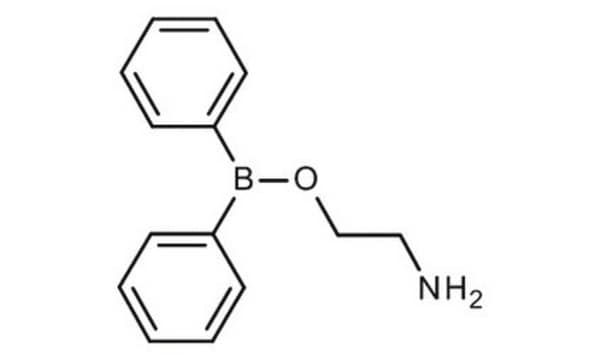100065
2-APB
≥97% (titration), crystalline solid, Ins(1,4,5)P3-induced Ca2+ release inhibitor, Calbiochem®
Sinonimo/i:
2-APB, 2-Aminoethoxydiphenylborate, (2-Aminoethoxy)diphenylborane
Scegli un formato
Scegli un formato
About This Item
Prodotti consigliati
Nome del prodotto
2-APB, A cell-permeable modulator of Ins(1,4,5)P3-induced Ca2+ release.
Livello qualitativo
Descrizione
RTECS - ED6150000
Saggio
≥97% (titration)
Stato
crystalline solid
Produttore/marchio commerciale
Calbiochem®
Condizioni di stoccaggio
OK to freeze
desiccated (hygroscopic)
Colore
white
Solubilità
DMSO: 20 mg/mL
95% ethanol: 25 mg/mL
Condizioni di spedizione
ambient
Temperatura di conservazione
2-8°C
Stringa SMILE
B(OCCN)(c2ccccc2)c1ccccc1
InChI
1S/C14H16BNO/c16-11-12-17-15(13-7-3-1-4-8-13)14-9-5-2-6-10-14/h1-10H,11-12,16H2
BLZVCIGGICSWIG-UHFFFAOYSA-N
Descrizione generale
Azioni biochim/fisiol
Ins(1,4,5)P3-induced Ca2+ release
Confezionamento
Attenzione
Ricostituzione
Altre note
Gregory, R.B., et al. 2001. Biochem. J.354, 285.
Ma, H.T., et al. 2001. J. Biol. Chem.276, 18888.
Ascher-Landsberg, S., et al. 1999. Biochem. Biophys. Res. Commun.264, 979.
Maruyama, T., et al. 1997. J. Biochem.122, 498.
Note legali
Avvertenze
Warning
Indicazioni di pericolo
Consigli di prudenza
Classi di pericolo
Eye Irrit. 2 - Skin Irrit. 2 - STOT SE 3
Organi bersaglio
Respiratory system
Codice della classe di stoccaggio
11 - Combustible Solids
Classe di pericolosità dell'acqua (WGK)
WGK 3
Punto d’infiammabilità (°F)
Not applicable
Punto d’infiammabilità (°C)
Not applicable
Certificati d'analisi (COA)
Cerca il Certificati d'analisi (COA) digitando il numero di lotto/batch corrispondente. I numeri di lotto o di batch sono stampati sull'etichetta dei prodotti dopo la parola ‘Lotto’ o ‘Batch’.
Possiedi già questo prodotto?
I documenti relativi ai prodotti acquistati recentemente sono disponibili nell’Archivio dei documenti.
I clienti hanno visto anche
Active Filters
Il team dei nostri ricercatori vanta grande esperienza in tutte le aree della ricerca quali Life Science, scienza dei materiali, sintesi chimica, cromatografia, discipline analitiche, ecc..
Contatta l'Assistenza Tecnica.
















